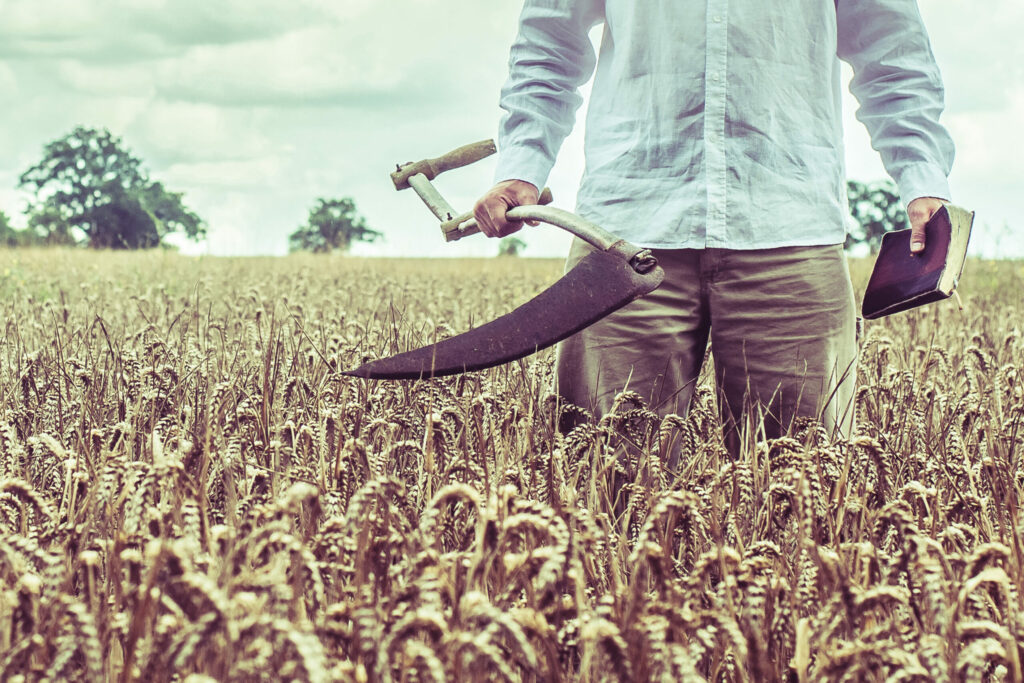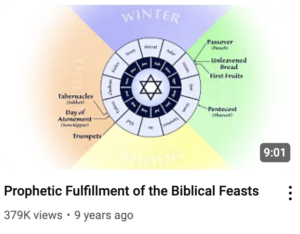
“For the testimony of Jesus is the spirit of prophecy.” Rev. 19:10
At the midpoint of the final seven years (Daniel’s 70th week), the Anti-Messiah will desecrate the temple in Jerusalem. This is the Abomination of Desolation, beginning the final 3.5 years called the Great Tribulation. At the end of the Great Tribulation, we reach the day of which nearly every biblical prophet spoke, the Day of the Lord. One of the main causes of confusion in the book of Revelation is that it builds up to the Day of the Lord several times, and just before it tells you the good part, it interrupts the story with an aside or it jumps back in time to show another perspective on the events leading up to that day. In this article, we will work through several of these narrative jumps to highlight the clear chronological sequence of events, especially at the end of the Great Tribulation.
The Feast Days in the Great Tribulation
The Day of the Lord and return of Messiah is strongly correlated with the fall feast days: Yom Teruah, Yom Kippur, and Sukkot. Six months before these holy days, we have the spring feasts of Pesach (Passover) and Unleavened Bread. The Abomination of Desolation is likely to happen on Pesach, one of the holiest days of the year, 3.5 years before the return of the Lord. For more background on this idea, check out our video Prophetic Fulfillment of the Biblical Feasts.
From the time of the Abomination of Desolation, Jerusalem and the court of the Temple will be “given to the Gentiles, and they will trample over the holy city for forty-two months” (Rev. 11:2). The two prophets are witnessing in Jerusalem during this time. At the end of the Great Tribulation, they are killed, and after 3.5 days, they are resurrected and called up to Heaven. The flow of chronology from chapter 11 to chapter 14 suggests that this is not a special, stand-alone event, but rather the beginning of the global rapture/resurrection at the return of Messiah.
The End of the Great Tribulation
Chapter 11 ends with the 7th trumpet (11:15-19), which initiates a scene in Heaven. The angels and saints declare that the time has come for final judgement and the beginning of Messiah’s rule, which connects us back to these previous passages:
Sixth Seal:
“Then I watched as he broke the sixth seal, and there was a great earthquake, the sun turned black as sackcloth worn in mourning, and the moon became blood-red. The stars fell from heaven to earth just as a fig tree drops its figs when shaken by a strong wind. The sky receded like a scroll being rolled up, and every mountain and island was moved from its place. Then the earth’s kings, the rulers, the generals, the rich and the mighty — indeed, everyone, slave and free — hid himself in caves and among the rocks in the mountains, and said to the mountains and rocks, ‘Fall on us, and hide us from the face of the One sitting on the throne and from the fury of the Lamb! For the Great Day of their fury has come, and who can stand?’” Rev. 6:12-17
Seventh Trumpet:
“There will be no more delay; on the contrary, in the days of the sound from the seventh angel when he sounds his shofar, the hidden plan of God will be brought to completion, the Good News as he proclaimed it to his servants the prophets.” Rev. 10:6b-7
“The seventh angel sounded his shofar; and there were loud voices in heaven, saying,
‘The kingdom of the world
has become the Kingdom
of our Lord and his Messiah,
and he will rule forever and ever!’” Rev. 11:15
Chapter 11 ends with the Temple in Heaven opening to reveal the Ark of the Covenant (v.19). Chapters 12 and 13 are an aside to explain the origin of the beast (Anti-Messiah), and then chapter 14 resumes the scene in Heaven where we left it in chapter 11. When 14:1 says, “there was the Lamb standing on Mount Zion; and with him were 144,000”, I see this as the heavenly Jerusalem (compare to Hebrews 12:22) from which Jesus and his saints are about to return. The 144,000 are the Messianic Jews mentioned in Revelation 7 and the “full number” of the martyrs mentioned in Revelation 6:11.
The Rapture/Resurrection
Chapter 14 proceeds with angels proclaiming three messages over the earth: the Gospel, the announcement of Mystery Babylon’s fall, and a warning not to worship the Anti-Messiah. These are the final chance for anyone to respond to God’s mercy, because Messiah is on His way to judge the earth and set up His kingdom.
Then the rapture/resurrection takes place:
“Then I looked, and there before me was a white cloud. Sitting on the cloud was someone like a Son of Man with a gold crown on his head and a sharp sickle in his hand. Another angel came out of the Temple and shouted to the one sitting on the cloud, ‘Start using your sickle to reap, because the time to reap has come — the earth’s harvest is ripe!’ The one sitting on the cloud swung his sickle over the earth, and the earth was harvested.” Rev. 14:14-16
The end of chapter 14 (v.17-20) summarizes the bowl judgments as the treading of the winepress of God’s wrath, which chapters 15 and 16 describe in detail.
Setting aside chapters 12 and 13, Revelation 11:11 through 14:16 is all describing a continuous series of events on the same day. The end of chapter 14 (summarizing the bowl judgments) appears to happen over the course of several days, possibly between Yom Teruah and Yom Kippur.
Armageddon and the Bowl Judgments
The events of the bowl judgments in chapters 15 and 16 coincide with the return of Jesus, the final battle (aka Armageddon), and His march to Jerusalem. Put another way, the bowl judgments are the means by which Jesus fights the final battle. Chapters 17 and 18 are another aside about Mystery Babylon, and then chapter 19 is a vision of Jesus that compliments chapters 14-16. He goes forth from the Temple in Heaven on a white horse accompanied by the armies of Heaven and He treads the winepress of God’s wrath (bowl judgments, final battle).
There is a great deal of curiosity about “the battle of Armageddon”, so we made an entire video about it.
Revelation moves through this time period swiftly and focuses on the cataclysmic plagues that accompany the Day of the Lord. Many other parts of the Bible provide details about what happens in the days immediately following the bowl judgments and the return of Messiah:
- The marriage supper of the Lamb
- Jesus judges the nations (think tribunal as opposed to the plagues of judgement)
- The resurrected saints join Jesus in ruling the earth (Rev. 20:4)
- There is a years-long process of cleanup and reconstruction (Ez. 39)
- All nations submit to Messiah’s authority and celebrate Sukkot in Jerusalem annually (Zech. 14:16)
- The Earth is restored to an Eden-like state
In Revelation 20, Satan is bound and Jesus begins His millennial reign. After 1,000 years, Satan is allowed one final rebellion, and then cast into the lake of fire forever. At this point, Jesus holds the Great White Throne Judgement, where all the living and the dead are judged — except those whose names are written in the Book of Life (Rev. 20:15).
The Book of Life
How do you get your name written in the Book of Life and escape the Great White Throne Judgement? This is perhaps the least mysterious part of Revelation: “Blessed and holy is anyone who has a part in the first resurrection; over him the second death has no power” (Rev. 20:6a). If you believe in Jesus now, before His return, you will be part of the first resurrection and you never have to fear judgement again. The Book of Life will also contain the names of those who survive the Great Tribulation and then turn to the Lord, and those who are born during the Millennium and serve Messiah faithfully, but they still must pass through that final judgment. We who live in the present age have the greatest and simplest opportunity for eternal security, because now is the time we can receive Him by faith. In the Day of the Lord, every eye will see Him and faith, at least in the manner and to the degree that we now depend on it, will no longer be possible. Don’t let that opportunity pass you by!
All Scripture taken from Complete Jewish Bible (CJB). Photo credit: Mission Media, Lightstock.com.






